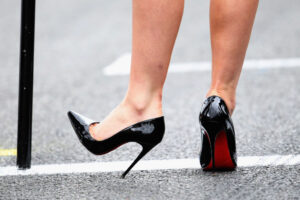
Trademarking A Color In The World Of Fashion Is Easier Said Than Done

(Photo by Ker Robertson/Getty Images)
Trademark protection for colors holds significant value as colors have become important marketing tools for brands, particularly in the evolving trend of minimalistic branding with fewer logos. One example is the success of Bottega Veneta, which experienced a resurgence in popularity in 2021 after a rebranding effort. As part of this effort, Bottega introduced products with its prominent “Bottega Green” color during Bottega’s spring 2021 ready-to-wear collection. The vibrant color brought a young and modern vibe to the company and contributed to increasing sales by 9.3% from 2020. “Bottega Green” was even named color of the year in 2021 by many media outlets. By introducing a distinct and memorable bright green hue, Bottega was successful in creating a strong visual association between the color and the brand.
googletag.cmd.push( function() { // Display ad. googletag.display( "div-id-for-top-300x250" ); });Similar to Bottega Veneta, many iconic brands have successfully associated themselves with a particular hue, promoting immediate recognition in the eyes of consumers. From Tiffany & Co.’s iconic blue to Christian Louboutin’s vibrant red, these colors have become synonymous with the companies they represent. While it is acknowledged that color alone may be the subject of a trademark, obtaining a trademark registration for a color is more challenging than for more typical word or logo marks. I will explore the importance of single-color marks and some of the specific challenges brands face in this process of obtaining them.
 Sponsored How Overture Law Is Revolutionizing Referral Fees LegalZoom's founder has launched a new platform where solos and small firms can refer clients to one another and ethically share in fees. From Above the Law
Sponsored How Overture Law Is Revolutionizing Referral Fees LegalZoom's founder has launched a new platform where solos and small firms can refer clients to one another and ethically share in fees. From Above the Law Courts in the United States have acknowledged that a single-color mark is not inherently distinctive for the purpose of eligibility for federal trademark registration. Moreover, the statutory definition of trademarks does not include color. However, the Supreme Court in Qualitex Co. v. Jacobson Products Co., acknowledged that color alone can be eligible for trademark protection where it has acquired distinctiveness in the minds of the consumers. Establishing that a color has acquired distinctiveness (sometimes called “secondary meaning”) is not a simple matter. It requires the applicant or plaintiff to provide persuasive evidence that the color has come to identify the source of the goods — without serving any other significant function. Factors that can prevent a color from serving as a source identifier include purely ornamental purposes, where the color is used solely for aesthetic appeal or to make an object visually appealing. If a color is primarily “functional” or utilitarian, it may not acquire the necessary distinctiveness to indicate source, and cannot, therefore, serve as a trademark. Examples include using a specific color to indicate flavor (brown for chocolate), or characteristics of a product (red for “hot,” yellow or orange for visibility/“caution.”).
The most famous example of a single-color mark in the industry involves the famous shoe brand, Christian Louboutin, which has been using a distinct red color on the soles of its shoes since 1992. Louboutin filed a trademark application in 2008 for the red outer sole design element on its shoes, which was approved by the USPTO. In 2011, Louboutin filed a lawsuit against Yves Saint Laurent (YSL), alleging that YSL infringed on its red sole trademark by selling a monochrome red shoe that also included a red sole. The District Court had originally rejected Louboutin’s claim, stating that color was per se not capable of being a trademark. YSL filed a counterclaim seeking to invalidate Louboutin’s red sole mark and registration on grounds including that the color red as used was not distinctive, but instead merely ornamental and functional, and have long been used on outer soles by many other brands. The Second Circuit found error in the District Court’s decision and held that the red sole mark was a valid and enforceable trademark where the red soles contrasted with the shoes’ upper component because the red sole had acquired distinctiveness — secondary meaning. Specifically, the Second Circuit recognized that Louboutin had met the test of showing distinctiveness, such that that the color became a symbol of the brand — a trademark. This evidence included the designer’s advertising expenditures, media coverage, and sales success over 20 years of use and fostered worldwide recognition insofar as the red sole popped in contrast to the color of the upper part of the shoe. However, the court found that because Louboutin’s trademark was limited to uses in which the red outer sole contrasts with the color of the remainder of the shoe, and Louboutin sought to enjoin YSL from using a red sole as part of a monochrome red shoe, the District Court’s denial for an injunction against YSL is affirmed.
googletag.cmd.push( function() { // Display ad. googletag.display( "div-id-for-middle-300x250" ); }); googletag.cmd.push( function() { // Display ad. googletag.display( "div-id-for-storycontent-440x100" ); }); googletag.cmd.push( function() { // Display ad. googletag.display( "div-id-for-in-story-youtube-1x1" ); });Besides Christian Louboutin, other notable examples of companies successfully acquiring trademark rights for specific colors include UPS, and Tiffany & Co. UPS holds a service mark registration for its distinctive “Pullman” brown color, which is used as a service mark on delivery vehicles and clothing of delivery personnel. Tiffany & Co. has maintained trademarks and service marks for its iconic robin’s egg blue since the 1990s, covering a wide range of goods and services that have become synonymous with the brand. The association of Tiffany & Co. with the blue color dates back to as early as 1889, further solidifying its status as a recognized and protected brand identifier.
In addition to securing trademarks for their actual products, brands often seek trademark registration for their product packaging, which can be easier to obtain. For example, Hermès has secured trademark rights for a specific orange hue used on the exterior of their merchandise boxes and Glossier has trademark rights for its pink shade as applied to bags holding its cosmetics and skincare products.
Sponsored Sponsored Artificial Intelligence For Law Firms: A Practical And Tactical Guide The legal profession stands on the brink of an AI-driven evolution. This comprehensive primer will bring any lawyer up to speed. From InfoTrack and Above The Law
Sponsored Artificial Intelligence For Law Firms: A Practical And Tactical Guide The legal profession stands on the brink of an AI-driven evolution. This comprehensive primer will bring any lawyer up to speed. From InfoTrack and Above The Law  Sponsored How Overture Law Is Revolutionizing Referral Fees LegalZoom's founder has launched a new platform where solos and small firms can refer clients to one another and ethically share in fees. From Above the Law
Sponsored How Overture Law Is Revolutionizing Referral Fees LegalZoom's founder has launched a new platform where solos and small firms can refer clients to one another and ethically share in fees. From Above the Law  Sponsored The Digital Transformation Imperative Private funds’ in-house and external legal teams are stretched thin by growing legal demands. Firms need digital transformation to thrive. From Troy Pospisil, Ontra CEO
Sponsored The Digital Transformation Imperative Private funds’ in-house and external legal teams are stretched thin by growing legal demands. Firms need digital transformation to thrive. From Troy Pospisil, Ontra CEO  Sponsored Take Your Firm’s Work To The Next Level With Neos With endless customization options and a robust suite of integrations, Assembly Software’s Neos is a powerful, cloud-based platform ideal for today’s forward-thinking attorneys. From Assembly Software and Above The Law
Sponsored Take Your Firm’s Work To The Next Level With Neos With endless customization options and a robust suite of integrations, Assembly Software’s Neos is a powerful, cloud-based platform ideal for today’s forward-thinking attorneys. From Assembly Software and Above The Law In Wal-Mart Stores, Inc. v. Samara Bros., Inc., 529 U.S. 205 (2000), the Supreme Court considered a trademark suit involving the configuration of baby clothes. It famously held that product configurations could never be “inherently distinctive,” and required a showing of acquired distinctiveness, while product packaging could be inherently distinctive depending on the facts. Moreover, the Federal Circuit relied on Wal-Mart v. Samara to highlight the difference between colors applied to the products themselves and colors applied to the product packaging. In that case, the Federal Circuit recognized that a multi-color mark used on product packaging does not require acquired distinctiveness, but “can be inherently distinctive when used on product packaging, depending upon the character of the color design.” Referring to the Supreme Court, the Federal Circuit noted that “inherent distinctiveness turns on whether consumers would be predisposed to ‘equate the [color] feature with the source.'”
However, for many companies, color does not act as a strong enough source indicator to acquire trademark protection. A notable example is General Mills’ attempt to register a trademark for the yellow color of the box in which Cheerios cereal has been packaged since the 1940s. The Trademark Trial and Appeal Board (TTAB) denied the application, reasoning that General Mills failed to show that consumers equate the yellow color with the brand. The TTAB also noted that the fact that other companies also use yellow boxes for cereal indicates that the yellow serves as “eye-catching ornamentation customarily used for the packaging of breakfast cereals generally,” rather than a source identifier.
As the Supreme Court recently affirmed in Abitron Austria GmbH v. Hetronic Int’l, Inc., No. 21-1043 (2023), trademark rights are territorial. For example, Japan serves as a good illustration that trademark laws and regulations vary by country or region (e.g. the European Union). While the Japan Patent Office (JPO) has approved of multi-color marks such as the red, orange, and green 7-Eleven signs, the JPO has to date rejected the registration of all single-color marks. Hermès and Louboutin have even faced significant challenges when trying to obtain the same trademark protection they maintain in the United States in Japan. For example, in May 2023, the JPO rejected an appeal from Hermès for the registration of its orange and brown colors as used on its packaging. Hermès presented evidence of a survey of high-income individuals in their 30s to 50s where 43.1% of individuals identified Hermès when shown its signature orange and brown boxes in order to prove acquired distinctiveness. However, the JPO maintained that the survey pool was too narrowly limited and even within the pool less than half linked the colors to the brand.
googletag.cmd.push( function() { // Display ad. googletag.display( "div-id-for-bottom-300x250" ); });Moreover, the United States is unique in according trademark rights based on actual use of the mark in commerce. Consequently, even if the USPTO may not recognize a company’s color mark as eligible for registration, there is a chance the District Court might.
While single-color marks can gain trademark protection, registration of a single color is still more the exception than the rule. Companies can enhance the value of their resources by consulting trademark counsel to select, market, and promote their color within a carefully crafted plan to acquire distinctiveness.
Sponsored Sponsored Advancing AI Safety: Law Student Competition For Drafting A Treaty On Moratorium Of Large-Scale AI Capabilities R&D To enforce a regime that will allow humanity to continue to exist, countries need to pass appropriate laws and enter international treaties. From Campaign for AI Safety
Sponsored Advancing AI Safety: Law Student Competition For Drafting A Treaty On Moratorium Of Large-Scale AI Capabilities R&D To enforce a regime that will allow humanity to continue to exist, countries need to pass appropriate laws and enter international treaties. From Campaign for AI Safety  Sponsored Take Your Firm’s Work To The Next Level With Neos With endless customization options and a robust suite of integrations, Assembly Software’s Neos is a powerful, cloud-based platform ideal for today’s forward-thinking attorneys. From Assembly Software and Above The Law
Sponsored Take Your Firm’s Work To The Next Level With Neos With endless customization options and a robust suite of integrations, Assembly Software’s Neos is a powerful, cloud-based platform ideal for today’s forward-thinking attorneys. From Assembly Software and Above The Law  Nicolette Shamsian joined Above the Law as a fashion law columnist in 2023. Nicolette earned her B.A., summa cum laude, in Political Science and minor in Entrepreneurship from the University of California, Los Angeles and her Juris Doctor from UCLA School of Law. Nicolette is currently an associate in the Litigation group at Irell & Manella. Nicolette’s work at Irell focuses on intellectual property litigation. As Irell’s resident fashion law aficionado, Nicolette enjoys leading discussions to keep attorneys in the firm up to date on noteworthy fashion law cases.
Nicolette Shamsian joined Above the Law as a fashion law columnist in 2023. Nicolette earned her B.A., summa cum laude, in Political Science and minor in Entrepreneurship from the University of California, Los Angeles and her Juris Doctor from UCLA School of Law. Nicolette is currently an associate in the Litigation group at Irell & Manella. Nicolette’s work at Irell focuses on intellectual property litigation. As Irell’s resident fashion law aficionado, Nicolette enjoys leading discussions to keep attorneys in the firm up to date on noteworthy fashion law cases.
ATL Fashion, Biglaw, Fashion, Intellectual Property, Irell & Manella, Nicolette Shamsian, Trademark
Introducing Jobbguru: Your Gateway to Career Success
The ultimate job platform is designed to connect job seekers with their dream career opportunities. Whether you're a recent graduate, a seasoned professional, or someone seeking a career change, Jobbguru provides you with the tools and resources to navigate the job market with ease.
Take the next step in your career with Jobbguru:
Don't let the perfect job opportunity pass you by. Join Jobbguru today and unlock a world of career possibilities. Start your journey towards professional success and discover your dream job with Jobbguru.
Originally posted on: https://abovethelaw.com/2023/07/trademarking-a-color-in-the-world-of-fashion-is-easier-said-than-done/